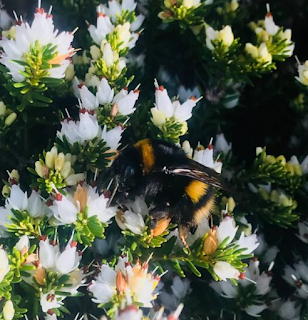"Distinguishing Bumblebees, Solitary Bees, and Honeybees: Know the Difference"
Bumblebees, Solitary Bees, and Honeybees: Unique Characteristics
In the vibrant world of bees, distinguishing between bumblebees, solitary bees, and honeybees unveils a fascinating tapestry of behaviors and life cycles.
1. Bumblebees: In Ireland, bumblebees flourish, with over 100 native species, including the Buff-tailed bumblebee. These social insects form large colonies during summer, often nested underground, even utilizing abandoned mouse burrows. The bumblebee colony commences in spring when a solitary queen establishes a nesting site. Initially, the queen's offspring are all female worker bees who aid her in laying successive broods of eggs throughout the summer. Male bees are only produced later in the season. As summer wanes, the old queen and her workers complete their lifecycle. A few late-born queens survive to hibernate and begin new colonies in spring.
2. Solitary Bees: Solitary bees represent a group of approximately 80 bee species in Ireland. Unlike their social counterparts, solitary bees don't form colonies. Instead, they construct individual nests. Each female solitary bee builds her nest, lays her eggs, and provides pollen and nectar provisions for her offspring. Notably, solitary bees are not 'social' bees and do not engage in cooperative nesting or hive activities.
3. Honeybees: Unlike native Irish bees, honeybees, while playing a pivotal role in pollination, are not indigenous and have been managed for honey production. Honeybees follow an annual life cycle, requiring no honey stores. They've evolved in climates where they survive through winter and thus need honey reserves. Beekeepers maintain honeybees in hives, but this managed pollination activity primarily serves honey production rather than conservation. It's important to understand that honeybees are not in decline, and their addition to an area can even challenge wild bees by competing for limited pollen and nectar resources.
Conservation Matters: As wild bee populations face threats, actions to protect them are imperative. Factors such as land management, soil compaction, monoculture farming, excessive mowing of grasslands, and inadequate tree cover are contributing to bee habitat loss. Pesticides, especially glyphosate, pose significant risks to bees by killing off flowering plants, reducing food sources, and harming their health.
How to Help: Conserving wild bees requires collective effort. Communities, local authorities, farmers, and businesses can contribute significantly. To bolster wild bee populations, initiatives like maintaining fields full of flowering plants, allowing lawns to grow naturally, and encouraging native trees to flourish can be far more effective than honeybee beekeeping. Moreover, reducing pesticide usage is critical to safeguarding bees and other pollinators.
Conclusion: Understanding the distinctions between bumblebees, solitary bees, and honeybees is essential in the context of bee conservation. While honeybees play a vital role in pollination and honey production, their managed status differentiates them from native wild bee species. To combat the decline of wild bees, a concerted effort is required to address the various threats and foster bee-friendly environments.
#Bumblebees, #SolitaryBees, #Honeybees, #BeeConservation, #WildBees, #Pesticides, #Pollinators, #HabitatProtection, #IvyBee, #dambeekeeper, #climatestory, #environmentalstory, #carbonstory

